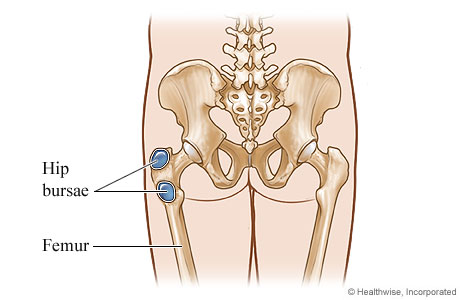Hip bursitis: Overview
Bursitis is inflammation of the bursa. A bursa is a small sac of fluid that cushions a joint and helps it move easily. A bursa sits between a bone in the hip and the muscles and tendons in the thigh and buttock. Injury or overuse of the hip can cause bursitis. Activities that can lead to bursitis include twisting and rapid joint movement. Bursitis can cause hip pain.
Bursitis usually gets better if you avoid the activity that caused it. If pain lasts or gets worse despite home treatment, your doctor may draw fluid from the bursa through a needle. This may relieve your pain and help your doctor know if you have an infection. If so, your doctor will prescribe antibiotics. If you have inflammation only, you may get a corticosteroid shot to reduce swelling and pain. Sometimes surgery is needed to drain or remove the bursa.
What are the symptoms of trochanteric bursitis?
Symptoms of trochanteric bursitis may include:
- Hip pain, and sometimes buttock pain that spreads down the outside of the thigh to the knee area. Pain may be worse during activities such as walking, running, or sitting cross-legged with the leg over the opposite knee. Pain may be severe enough at night that it disturbs your sleep.
- Tenderness when you press on the affected area or lie on the affected side.
- Limping.
- Swelling from increased fluid within the bursa.
- Redness and warmth (from inflammation or infection).
How is hip bursitis treated?
Home treatment is often enough to reduce pain and let the bursa heal. Your doctor may give you a shot of medicine to reduce pain and swelling. The doctor may also suggest physical therapy to strengthen the muscles around your hip joints. Some people need surgery to drain or remove the bursa.
How can you prevent hip pain from bursitis or a tendon injury?
Bursitis or a tendon injury (tendinopathy) can cause pain at the side of your hip when you rise from a chair and take your first few steps, climb stairs, drive, or lie down with direct pressure on the side of the hip.
To prevent and ease hip pain during work, play, or daily activities:
- Stay at a weight that's healthy for you. Talk to your doctor if you need help losing weight.
- Wear well-cushioned shoes, and avoid high heels.
- Walk up and down stairs one at a time, leading with your strong leg when you go up stairs or curbs, and with your weaker or sore leg when you go down.
- Warm up before activities.
- Avoid activities that make one side of the pelvis higher than the other, such as running in only one direction on a track or hiking or doing yard work sideways on a slope. Keep your hips level.
- Sleep on your uninjured side with a pillow between your knees, or on your back with pillows beneath your knees.
- Stretch after an activity, when your muscles are warm.
How is hip bursitis diagnosed?
Your doctor will do a physical exam and ask questions about your hip and overall health. During the exam, the doctor will look at your hip and check for tenderness. You may also have imaging tests, such as an X-ray, an ultrasound, or an MRI.
How can you care for yourself when you have hip bursitis?
- Put ice or a cold pack on your hip for 10 to 20 minutes at a time. Put a thin cloth between the ice and your skin.
- After 3 days of using ice, you may use heat on your hip. You can use a hot water bottle, a heating pad set on low, or a warm, moist towel.
- Rest your hip. Stop any activities that cause pain. Switch to activities that do not stress your hip.
- Take your medicines exactly as prescribed. Call your doctor if you think you are having a problem with your medicine.
- Ask your doctor if you can take an over-the-counter pain medicine, such as acetaminophen (Tylenol), ibuprofen (Advil, Motrin), or naproxen (Aleve). Be safe with medicines. Read and follow all instructions on the label.
- To prevent stiffness, gently move the hip joint as much as you can without pain every day. As the pain gets better, keep doing range-of-motion exercises. Ask your doctor for exercises that will make the muscles around the hip joint stronger. Do these as directed.
- You can slowly return to the activity that caused the pain, but do it with less effort until you can do it without pain or swelling. Be sure to warm up before and stretch after you do the activity.
Bursitis of the Hip

Bursitis of the hip is inflammation of one or both of the bursae (plural of bursa) found between the hip bone and the muscles on the outside of the hip.
A bursa is a fluid-filled sac that cushions and lubricates areas of the body where friction is likely to occur. Examples of such areas include between two bones, between a tendon or ligament and a bone, and between bone and skin.
Hip bursitis: When to call
Call your doctor now or seek immediate medical care if:
- You have a fever.
- You have increased swelling or redness in your hip.
- You cannot use your hip, or the pain in your hip gets worse.
Watch closely for changes in your health, and be sure to contact your doctor if:
- You have pain for 2 weeks or longer despite home treatment.
©2011-2024 Healthwise, Incorporated